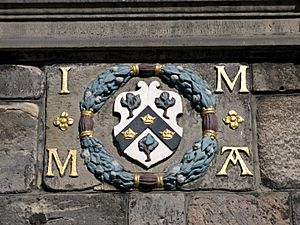James Cockie facts for kids
James Cockie (died 1573) was a skilled goldsmith in Edinburgh. He played a part in making coins inside Edinburgh Castle during a time of conflict called the Marian Civil War. Sadly, he was later put to death on August 3, 1573, for his actions related to coin making.
His family name was sometimes spelled "Cokie," "Cokkie," "Cokke," or "Cok." The Cockie family was well-known in Edinburgh for their goldsmith work. James Cockie was born around 1535. His father also had the name James Cockie.
Contents
James Cockie's Work as a Goldsmith
James Cockie and another goldsmith, James Mosman, became official members of the Edinburgh goldsmiths' group on May 1, 1557.
In 1558, James Cockie created and decorated a special clock case for Mary of Guise, who was the Queen Regent of Scotland. He also worked at Edinburgh Castle. There, he helped cast a large cannon called a "double falcon." This cannon featured the Queen's royal symbols and motto.
Cockie married the daughter of John Arres. Her sister, Marion Arres, was married to James Mosman. Through this marriage, Mosman gained ownership of a house on Edinburgh's famous High Street. This house is now known as the John Knox House.
Coin Making and the Marian Civil War
During the Scottish Reformation in 1560, James Cockie provided information to French officials. He was described as a talented maker and engraver of coins.
According to his statement, the Earl of Arran asked him to create a special seal. This seal would have the royal symbols of Mary, Queen of Scots and Francis II of France. He was also asked to make tools for minting coins. At first, Cockie refused. He said he wasn't used to such work and needed an order from the Queen Regent.
Later, he did work on a design for coins that featured a crown and the motto "Verbum Dei" (meaning "Word of God"). When a group called the Congregation left Edinburgh, he gave these coin-making tools to John Acheson, who worked at the mint.
In 1571, James Cockie and James Mossman joined William Kirkcaldy of Grange inside Edinburgh Castle. They chose to support Kirkcaldy, who held the castle for Mary, Queen of Scots, during the Marian Civil War.
Cockie and Mossman helped Kirkcaldy use the queen's jewels, which were stored in the castle, to get loans. Records show that Cockie was especially involved in receiving silver and making coins inside the castle. The coins made in the castle were of better quality than those made by the opposing side at Dalkeith. These coins included the eighty pence piece, also known as a half merk. In 1572, an English soldier named William Drury even sent one of Cockie's half merks to William Cecil as something new and interesting.
After the castle was captured, James Cockie, James Mossman, William Kirkcaldy of Grange, and his brother James Kirkcaldy were executed on August 3, 1573. They had been tried together at Holyrood House.
A writer named Robert Lindsay of Pitscottie mentioned James Cockie in his historical writings. He noted that Cockie was the one who "struck the coin" in Edinburgh Castle.
The Cockie Family of Goldsmiths
In 1581, James Cockie's son, who was also a goldsmith and named James Cockie, was allowed to get back his family's property by the Parliament of Scotland.
Another goldsmith, William Cockie, owned a house in the Canongate area of Edinburgh. This house sadly burned down in 1608 when his son, Archibald Cockie, was living there.
Special Objects Made by James Cockie
The National Museums of Scotland has a beautiful jug or ewer. It is made of rock crystal with silver-gilt decorations. Experts believe James Cockie and his workshop created these silver parts. The ewer's silver decorations were made in Edinburgh during the reign of Mary, Queen of Scots. The lid has the family symbols of John Erskine and Annabell Murray, Countess of Mar. Erskine became the Earl of Mar in 1565. The head of the goldsmiths who checked the silver work was George Heriot.
Another silver cup, made by Henry Thomson, was used at Forgue. This cup has Cockie's special mark from 1563, showing he was the head of the goldsmiths at that time. The cup was given to the church in 1633 by James Crichton of Frendraught.
Images for kids



